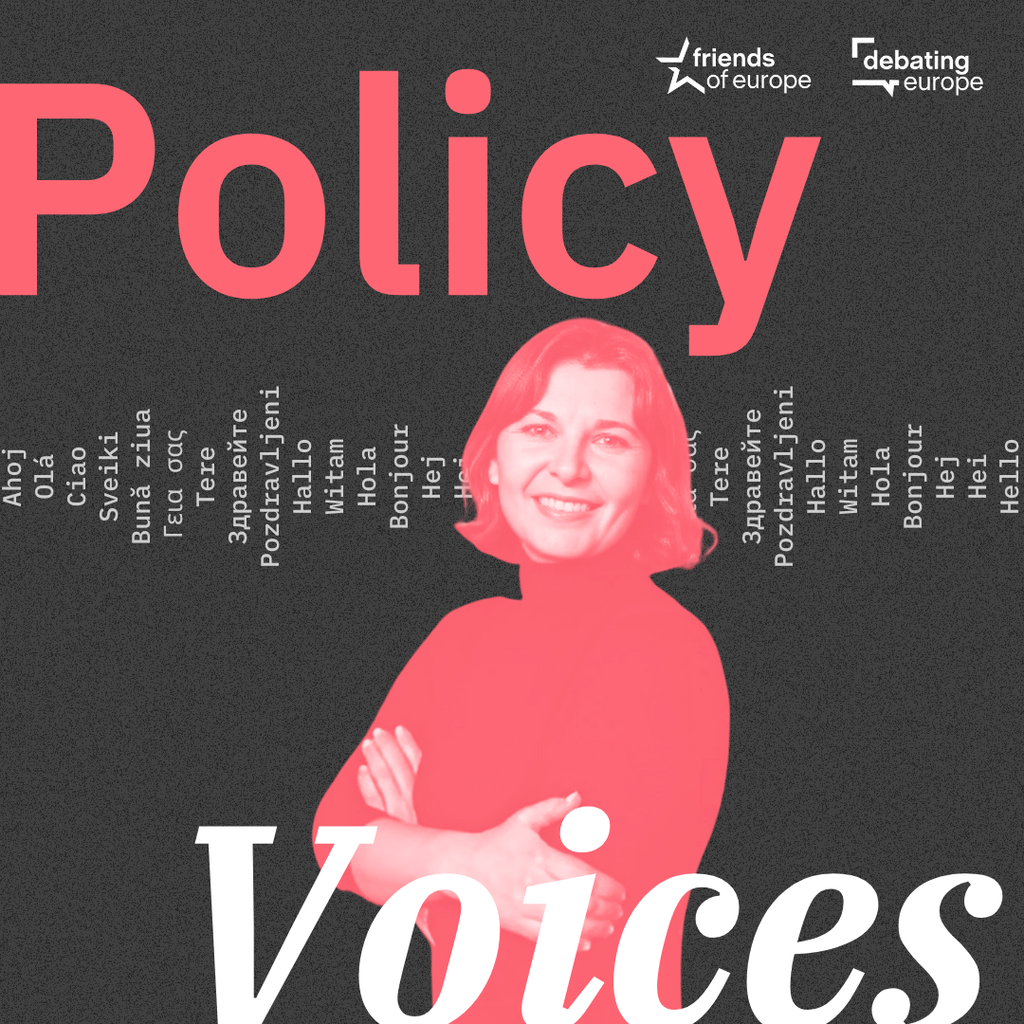From ambition to action: building Europe’s Defence Union
Past event In person

- Area of Expertise
- Peace, Security & Defence
Peace, Security & Defence

Senior Fellow for Peace, Security and Defence at Friends of Europe, and former Deputy Assistant Secretary General for Emerging Security Challenges at the North Atlantic Treaty Organization (NATO)
Last Friday, as our attention was fully seized with protest marches in the United States and throughout the world against racism and police brutality, a senior US official briefed the media on a decision by the US President Donald Trump to withdraw 9,500 American troops from Germany. This decision has not yet been communicated formally to either Germany or the United States’ other allies in NATO. Yet neither the White House nor the Pentagon has spoken publicly since last Friday to deny the story or clarify the reasoning behind this sudden decision. The senior US official who broke the news refuted the clear suspicion that this step was taken to punish Germany.
It is no secret that US-Germany relations have been cool to ice-cold during the Trump presidency. The President, and his outgoing ambassador in Berlin, Richard Grenell, have frequently castigated the Germans for failing to spend 2% of their GDP on defence (the NATO target) and for building the Nordstream pipeline under the Baltic Sea to bring more Russian natural gas to Western Europe. The recent refusal of Chancellor Angela Merkel to travel to the US for a meeting of the G7, to which Trump was trying also to invite Russia’s Vladimir Putin, (and which was acquiring a distinctly anti-China character), may have been the final straw in provoking Trump to lash out.
Yet this decision, which may have been taken for entirely political reasons, makes no strategic sense for the United States, let alone NATO. Today the US has nearly 60,000 troops permanently stationed in Europe (mainly in western Germany and Italy). This is around 20% of the number that were here during the Cold War and hardly the biggest strain on a Pentagon budget that this year is around $700bn. Germany, like other host countries of US forces, provides a good deal of local infrastructure and support. For decades the value to the US of having a permanent military presence in Europe has been uncontested within the Washington foreign policy elite and in the ranks of both Republican and Democrats in the Congress. Although isolationists like Pat Buchanan raised the issue in the early 1990s, the last serious push in Congress to link the threat of US troop withdrawals to offset payments by the European allies dates back to the Mansfield Amendments in the mid-1970s.
US leaders have generally followed the advice of their military commanders that a substantial US troop presence in Europe enhances deterrence and provides an initial defence screen against attack, giving reinforcements from the US time to arrive on the European battlefield. Moreover, these troops help to ensure interoperability with European forces through regular training exercises and command post simulations. Those European forces have access to the two large US training grounds in Germany, Hohenfels and Grafenwoehr, with their advanced technology firing ranges. The US troops and their families are embedded in the local German community and the links that they develop, both professionally and personally, are another piece of the connective tissue that holds NATO together over the long term. Finally, the US forces in Germany and the airbases, such as Spangdahlem or Ramstein, and barracks that they maintain gives the US an important staging post for projecting forces into North Africa or the Middle East at short notice. It is no coincidence in this respect that the US Africom command is co-located with the US European Command (EUCOM) in Stuttgart.
Trump’s bark has been worse than his bite
Some US and NATO officials will play down the impact and significance of the US troop reductions. They will point to the fact that the US and NATO have been following a collective defence strategy of rotating forces in and out of Central and Eastern Europe in response to Russia’s incursion into Ukraine in 2014. NATO calls this Enhanced Forward Presence, and the US has been a major contributor to this effort by keeping at all times the equivalent of an armoured brigade in Poland and prepositioning military equipment for another incoming brigade in a crisis or conflict. In all fairness, it needs to be pointed out that the UK, France and Canada withdrew all the forces that they had permanently deployed in Germany in the 1990s after the fall of the Berlin Wall. Like the US, they also commit forces today on a rotational basis. The UK leads the Alliance’s multinational battalion in Estonia, and Canada the one next door in Latvia.
It is also worth pointing out that the US has also contributed significant assets to NATO exercises on land, sea and in the air, which have been designed to restore the Alliance’s capacity for large scale reinforcement, manoeuvre and high-end warfighting after the focus on ‘out of area’ stabilisation and humanitarian operations after the end of the Cold War. These exercises, such as Trident Juncture or Anaconda, have involved the temporary return of thousands of US-based troops to Europe and also the sending of aircraft carriers and B2 and F117 stealth aircraft. In March, the largest US reinforcement exercise to date, Defender Europe, was going to send nearly 20,000 US troops to Poland and the Baltic states but had to be curtailed due to COVID-19. Yet most of the equipment for Defender Europe, sent in advance, did arrive and can be used for NATO’s summer exercises in the coming weeks.
The Trump administration has benefited NATO in other ways too. For instance, it spent $6.5 bn on military infrastructure and training in Europe in 2019 compared to $4.7 bn in 2018. For this year it has requested $5.9 bn from Congress. Other Trump initiatives, such as creating a new NATO Joint Forces Command in Norfolk, Virginia, to help protect the Atlantic maritime lines of communication, have been very welcome at NATO Headquarters too.
Consequently, it has been possible for supporters of NATO (and I have long been one of them) to claim that Trump’s bark has been worse than his bite and that actions speak louder than words. The withdrawal of 9,500 US troops from Germany is not the end of the world for NATO or the transatlantic security relationship. Certainly, a reduction of between one third and one-quarter of the troops in Germany is significant. Yet with its permanent and rotational forces, aircraft, Sixth Fleet in Naples, heavy equipment and tactical nuclear weapons based in five European countries, the US will still have a substantial military presence on this side of the Atlantic.
What if this is only the first step in more US disengagements?
Withdrawing so many soldiers and finding alternative bases for them in the US will take time (and cost plenty of money). There is some speculation that some of the troops could be relocated to Poland, which has announced already that it would be happy to receive them. At first sight this would make sense as NATO’s centre of gravity has shifted eastwards. Yet such a move would undoubtedly provoke Russia which would claim that it is a violation of the commitment in the NATO-Russia Founding Act of 1997 not to deploy NATO combat forces permanently in Eastern Europe. That said, the Trump administration’s decision to withdraw forces should not be played down or brushed aside purely because it does not pose an existential risk to NATO. The implications are not good for the Alliance, and what this decision portends for the future is as worrying as the decision itself.
In the first place is the impact on the US-Germany relationship. NATO was largely built around these security ties in the 1950s and 60s. They secured Germany’s anchorage in the West and its commitment to multilateralism and to European integration. As a result, Germany renounced possession of its own nuclear weapons and collectivised its military and defence policy within the NATO structures. During the Cold War, West Germany played host to nearly half a million foreign soldiers and thousands of tanks, aircraft and tactical nuclear weapons. Of course, we are in a different age now but the historical legacy that created this European and transatlantic Germany must not be blithely disregarded.
Trump has berated Germany for not reaching the NATO spending target, but the decision to unilaterally withdraw US forces, with no prior consultation with Berlin, ironically comes at a time when Germany was considerably increasing its defence effort. Its defence budget increased by 15% last year. Long-standing capability problems in the armed forces are finally being addressed, with orders for new tanks, frigates and medium-range air defence missiles. Germany has announced a plan to buy US F18 aircraft to continue with its nuclear sharing mission within NATO, as well as new Eurofighters. It has committed to building a 6th generation fighter aircraft with France as well as a new generation of armoured vehicles.
Some US commentators have claimed that these German efforts have enabled the US to reduce its own presence, but this is unlikely to be the political perception in Germany. The withdrawal will be seen in Berlin, and other Alliance capitals, as another, potentially dangerous step towards the renationalisation of defence whereby everyone has to fend for themselves with less trust and reliance on allies. What if this is only the first step in more US disengagements given that the 9,500 troops do not form part of any coherent reorganisation plan discussed and agreed within NATO? It will make it harder for the German government to make the case to its own citizens for greater efforts to meet NATO commitments, if NATO is no longer perceived as a community of shared destiny, and US troop deployments are purely a transactional service that have to be paid for.
Russia shows no signs of moderating its hostile behaviour
Already, many on the left and the Far Right in German politics are calling for the removal of US tactical weapons. If US troops leave, it will only embolden these voices to say that the US nuclear weapons should leave too. The debate will not just be about burden-sharing but Germany’s foreign policy and alignments more generally. NATO has always been based on the principle of reassurance and predictable commitments in exchange for the fair sharing of responsibilities and solidarity. If the reassurance is taken away and only individual national efforts remain, the essential transatlantic bargain that has made NATO so successful will start to disintegrate. Germany has always been, and always will be, the buttress of the entire NATO edifice. It is not the place to start experimenting.
It also seems strange to be reducing US troops in Europe at a time when Russia shows no signs of moderating its hostile behaviour towards NATO. It is continuing its major exercises close to the Alliance’s borders with little transparency and flying its aircraft aggressively close to NATO airspace. Last week Russia announced that it was adding six new ships to its Baltic fleet and last Friday, the day of the news of the US troop withdrawal emerged, Moscow also announced the deployment of an additional unit (a motorised rifle brigade ) to its Western Military District facing the Alliance. Russia has not engaged in serious talks with NATO on confidence-building and risk reduction measures and has of late refused to meet with the allies in the NATO-Russia Council. At the same time, Russia has not disengaged from Ukraine and is stepping up its military role close to NATO’s borders in places such as Libya. In the past, US troop reductions in Europe were linked to reciprocal moves by Russia and as part of binding agreements, such as Mutual Balanced Force Reduction (MBFR) in the 1970s or Conventional Forces in Europe (CFE) in the early 1990s. Yet this time, the US is giving Vladimir Putin an indication of a loosening commitment to Europe for free, with no corresponding limitations on exercises or transparency on force deployments close to borders on the Russian side.
Finally, the US decision, if confirmed and implemented, will inevitably encourage the advocates of European Strategic Autonomy to call again for a European defence that can reduce reliance on the United States. The COVID-19 crisis has shifted the debate in Brussels on European Strategic Autonomy away from the largely military domain of pooled capabilities and joint military R&D and procurement programmes where it was focused before. There has been much talk of adding the dimensions of diversified supply chains, foreign investment screening and European industrial champions in the high-tech sector. The pendulum will now probably swing back to the military side.
Yet more arguments for European Strategic Autonomy will not automatically conjure up more solutions. The non-European Union allies in NATO still contribute 80% of overall defence spending. Last year the International Institute for Strategic Studies in London calculated that it would cost the European allies up to $350 bn to replace the assets that the US contributes to their defence. European Strategic Autonomy was designed for limited EU missions in Africa or for humanitarian and peacekeeping roles further afield but not to take on big adversaries such as Russia in full scale and full-spectrum warfare on EU territory.
The US troop withdrawal may not ultimately happen
Moreover, as the COVID-19 crisis and the rise in geopolitical tensions increase the need for more EU autonomy, it also takes away the resources to make it happen. A year ago, the plan was to allocate €13.5 bn for the new EU Defence Fund and €6.5 bn for infrastructure upgrades to improve military mobility. Today these funding levels have come down to under €8 bn and €1 bn respectively in the ongoing discussions on the EU’s next seven-year financial framework (MFF).
So the EU finds itself in the opposite corner to the Trump administration. The latter speaks in negative terms but still spends money and sends forces (at least up to now). The EU, by contrast, says all the right multilateralist things and has noble ambitions; but the money and the troops do not follow – at least not in the right numbers and at the right speed. The next US administration may well be the necessary spur. If it is another four years of Trump, the Europeans may feel compelled to push boldly forward. If it is Biden, there will probably be more US encouragement for a European Strategic Autonomy, and more willingness to work with the EU to facilitate its initiatives while preserving NATO as the overall shield.
The US troop withdrawal may not ultimately happen. The Pentagon has been left to work out the details and may well resist this initiative from the White House, as it has recently pushed back against calls by Trump to deploy US regular forces on the streets of US cities. Many in Trump’s own Republican Party are also loyal supporters of NATO, and have voted repeatedly with their Democrat opponents over the last two years on Congressional resolutions of support for the Alliance and against suggestions from the President that he might withdraw the US from the NATO treaty. The Senate recently voted overwhelmingly to ratify North Macedonia’s membership of NATO even though that means one more European country that the US is now pledged to defend.
Yet at a time when NATO has been striving with success to get back into the serious business of collective defence and increasing its spending (while helping the US out in Afghanistan and Iraq), withdrawing 9,500 US troops from Europe is an unhelpful diversion. It produces no benefits for the US or Europe’s security, and only increases NATO’s reinforcement headache in finding the extra planes and ships to transport these troops back over the Atlantic in a crisis or conflict. If it is trying to make a point about burden sharing, that point has already been made and showing signs of success. If the more the Europeans spend, the more the US withdraws, the Europeans no longer have an incentive to spend. Above all this perplexing decision puts politics before serious security policy. This was never a wise thing to do – even in the days when the world was more peaceful.
Past event In person

Next event

Past event Online

Past event Online





Stay informed
We use cookies and similar technologies to adjust your preferences, analyze traffic and measure the effectiveness of our campaigns. Learn more about our privacy policy.